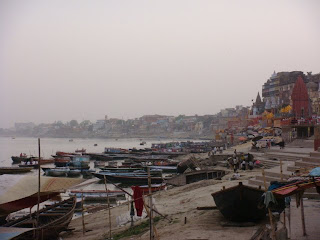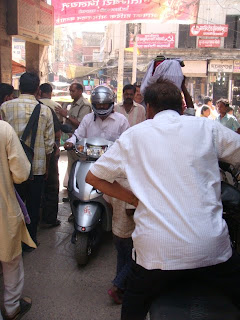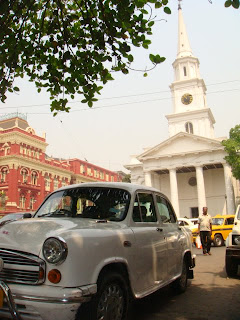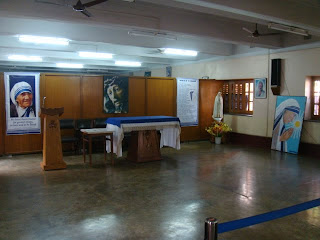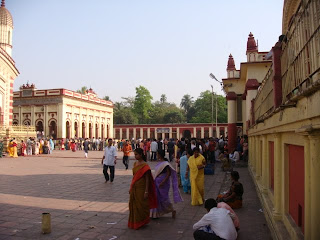Varanasi....the holiest city in India! We arrived from our overnight train from Kalcutta and were met at the train station by the son of the owner of the guest house. We followed him through an intricate pathway that lead us to our guest house. The buildings are build so closely together you feel like you are in a walled city. Indians flock to Varanasi for many reasons, but mostly to be by the Ganges River, or as the Indians call it -The Ganga! Our guest house was right in the thick of everything and each day we spent walking through these little alleyways. We also met a couple of really nice people staying at our guest house as well! To understand The Ganga, you have to understand how important it is to Indians. It is a river that is flanked on one side by lots of old buildings, 80 plus ghats(these are staircases that lead to the water) and many boats. The Indians think that the water is holy and by drinking it or bathing in it you cleanse yourself of all the bad. They also think that if you are cremated and put into the river your life is cleansed. If you are a holy person, a holy cow, or any animal, a baby, or a pregnant woman, you are already considered "cleansed" so they put your WHOLE body into the river with stones to weigh you down. SO, in this RIVER you have dead bodies, ashes, people swimming, people cleaning themselves, people drinking the water, and the city sewage spilling into the river!!! You would think it would smell, but it doesn't!!! People come to Varanasi to die, then their bodies are covered in cloth, and flowers, placed on wood and in front of the family burnt. A womans hip bone and A mans collarbone doesn't burn the whole way, so they throw that bit into the water! On our first night in Varanasi we took a boat ride and saw one of the cremation sites. It is said that the fires have NEVER stopped burning since the beginning of time, and they cremate bodies non-stop 24 hours a day! As we were in our boat, we saw about 2 bodies burning and 3 waiting to be burned. Our boatman thought it was would be nice to get us right up to the "burning Ghat" and we were almost hit with a woman's hip bone as it was tossed into the river. We asked him to please move us away from the ghat(where the cremation was being done) quickly!!! Each day thousands of Indians flock to Varanasi to go to the river and to go visit the holy temples. They bring gifts of flowers, holy water, and food to be placed at the temples. It would be hard to describe just how chaotic India can be, but I will try! So, as we walk down these narrow cobblestone paths, people are walking in each direction. Most are not wearing shoes. The ground is covered in cow and animal pooh and there are more cows and dogs sharing the same street than anyone can imagine. If you look up you see monkeys on the tops of all the buildings and they rule the tops of buildings in Varanasi. There is poverty and begging hands reaching out everywhere. There are children running, screaming, and having fun or children working and carrying items twice their weight. There are men 90 years old working, cycling people on their bikes, there are rich Indians and poor Indians sharing the same space on the roads. There are shops every 5 feet, and everyone is giving you the "best price". Everyone is either working or shopping, and it seemed that the men all worked and the women shopped. We had an incredible time in Varanasi and the day before we left we went down to the river to watch the nightly ceremony. There were lots of candles floating down the river, and many boats lining up for the ceremony(no dead bodies were seen).
Benarés (Varanasi) es una ciudad situada a orillas del río Ganges.
En la actualidad, los hinduistas la consideran una de las principales ciudades de peregrinación. La categoría de ciudad santa proviene de la creencia de que una de las cuatro cabezas del dios Brahmá consiguió descansar al llegar a esta ciudad.
Además, según la mitología hinduista, la mano izquierda de Satí (la esposa del dios Shivá, que se suicidó prendiéndose fuego) cayó en esta ciudad, teniendo cada una de estas divinidades su propio templo.
Según el hinduismo, todo aquel que muera en Benarés (o a menos de sesenta kilómetros de la ciudad), queda liberado del ciclo de las reencarnaciones. Los baños en el río Ganges se consideran purificadores de los pecados. En su paso por esta ciudad el río Ganges cuenta con un importante grado de contaminación. Según la tradición, todo hinduista debe visitarla al menos una vez en la vida.
Todas estas creencias han convertido la ciudad en el destino de enfermos y ancianos, que quieren pasar sus últimos días en la ciudad santa. A lo largo del Ganges se alinean numerosas residencias destinadas a albergar a los moribundos. La orilla del río es también el centro de los crematorios de la ciudad donde se pueden ver los cuerpos siendo cremados.
El escritor satírico estadounidense Mark Twain escribió: «Benarés es más antigua que la Historia, más antigua que las tradiciones, más vieja incluso que las leyendas, y parece el doble de antigua que todas juntas»
El principal destino de los peregrinos que visitan la ciudad son los ghats, nombre que reciben las escaleras de piedra que descienden hasta el Ganges. Al amanecer, se puede ver a hombres y mujeres realizando sus baños purificadores en el río a la vez que rinden tributo al dios del Sol, Surya. Cada una de estas escalinatas, construidas en el siglo XVIII, tiene un nombre y una función especial. Los ghats de Mani Karnika y Harischandra son los crematorios principales. En el ghat de Pancha Ganga se cree que convergen cinco ríos sagrados. En total, la ciudad cuenta con más de 100 ghats
Benarés (Varanasi) es una ciudad situada a orillas del río Ganges.
En la actualidad, los hinduistas la consideran una de las principales ciudades de peregrinación. La categoría de ciudad santa proviene de la creencia de que una de las cuatro cabezas del dios Brahmá consiguió descansar al llegar a esta ciudad.
Además, según la mitología hinduista, la mano izquierda de Satí (la esposa del dios Shivá, que se suicidó prendiéndose fuego) cayó en esta ciudad, teniendo cada una de estas divinidades su propio templo.
Según el hinduismo, todo aquel que muera en Benarés (o a menos de sesenta kilómetros de la ciudad), queda liberado del ciclo de las reencarnaciones. Los baños en el río Ganges se consideran purificadores de los pecados. En su paso por esta ciudad el río Ganges cuenta con un importante grado de contaminación. Según la tradición, todo hinduista debe visitarla al menos una vez en la vida.
Todas estas creencias han convertido la ciudad en el destino de enfermos y ancianos, que quieren pasar sus últimos días en la ciudad santa. A lo largo del Ganges se alinean numerosas residencias destinadas a albergar a los moribundos. La orilla del río es también el centro de los crematorios de la ciudad donde se pueden ver los cuerpos siendo cremados.
El escritor satírico estadounidense Mark Twain escribió: «Benarés es más antigua que la Historia, más antigua que las tradiciones, más vieja incluso que las leyendas, y parece el doble de antigua que todas juntas»
El principal destino de los peregrinos que visitan la ciudad son los ghats, nombre que reciben las escaleras de piedra que descienden hasta el Ganges. Al amanecer, se puede ver a hombres y mujeres realizando sus baños purificadores en el río a la vez que rinden tributo al dios del Sol, Surya. Cada una de estas escalinatas, construidas en el siglo XVIII, tiene un nombre y una función especial. Los ghats de Mani Karnika y Harischandra son los crematorios principales. En el ghat de Pancha Ganga se cree que convergen cinco ríos sagrados. En total, la ciudad cuenta con más de 100 ghats

 The children sell you these little flower/candle holders to float down the river. After you light it, you say all the members names in your family and it is supposed to bring them good luck!
The children sell you these little flower/candle holders to float down the river. After you light it, you say all the members names in your family and it is supposed to bring them good luck!
 The burning Ghat, were Indians come to cremate their family members, put their ashes in the river, then the family goes swimming just down stream.
The burning Ghat, were Indians come to cremate their family members, put their ashes in the river, then the family goes swimming just down stream.

 The night ceremony to give thanks and praise to the river. It is performed each night and thousands come to pray for the river.
The night ceremony to give thanks and praise to the river. It is performed each night and thousands come to pray for the river. We went to a house of an Indian man we met. His family has many cows and the cows get to live in the first floor of their house! So, this picture is of the cow INSIDE their house!
We went to a house of an Indian man we met. His family has many cows and the cows get to live in the first floor of their house! So, this picture is of the cow INSIDE their house! This is Sarnath, a small town about 30 minutes from Varanasi. This is the place that Buddha came for his first speech after his enlightenment. This is a very holy city for Buddhists.
This is Sarnath, a small town about 30 minutes from Varanasi. This is the place that Buddha came for his first speech after his enlightenment. This is a very holy city for Buddhists.
 Agustin and Linda, our good friend from Arizona that is traveling by herself around India! They are drinking Lassis!
Agustin and Linda, our good friend from Arizona that is traveling by herself around India! They are drinking Lassis! Getting Henna put on my hand. It is a temporary tattoo that Indian woman decorate themselves with. It lasts about 2 weeks!
Getting Henna put on my hand. It is a temporary tattoo that Indian woman decorate themselves with. It lasts about 2 weeks! Our favorite restaurant in Varanasi! They made everything you would want and the price was right!
Our favorite restaurant in Varanasi! They made everything you would want and the price was right!  This little boy worked at the restaurant, he was adorable!!!
This little boy worked at the restaurant, he was adorable!!! 